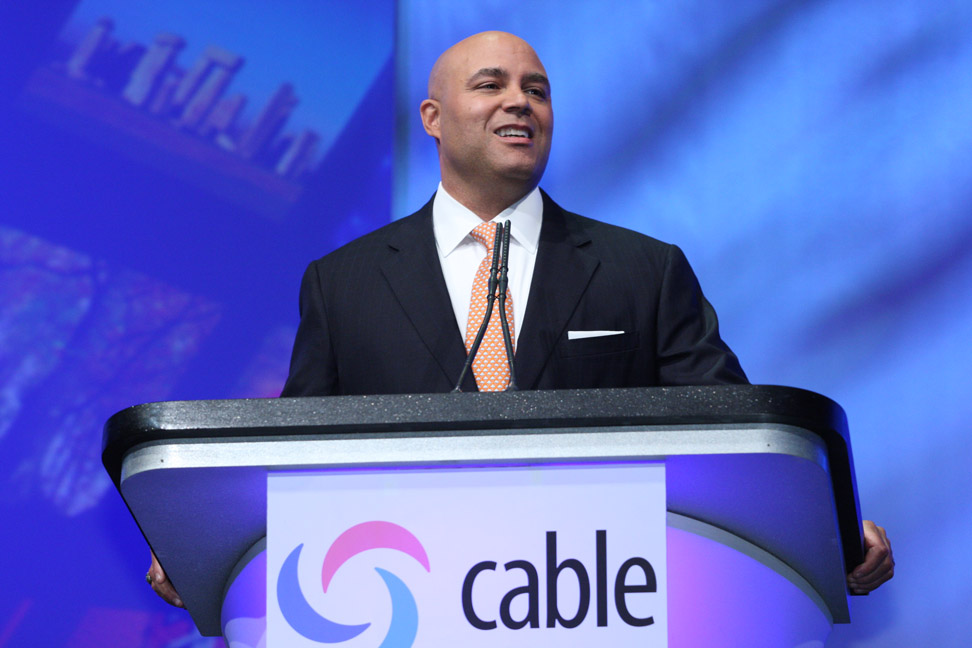Powell: TV's Golden Age Set Against Tarnished Rules
Washington -- National Cable & Telecommunications
Association president Michael Powell said Tuesday his Capitol Hill testimony
about the future of video will focus on three points: 1) that TV's golden age
is now; 2) that technology is driving choice and friction points between cable
and consumers should be removed; and 3) that the cable industry is not trying
to thwart over-the-top video.
Given those points, it's time to take a fresh look at
regulations that are premised on either a concentrated, vertically integrated
monopolist model of cable that doesn't exist or on subsidizing broadcasters and
protecting them from competition, he said during a press conference previewing his
remarks.
Whether national policy should still be predicated on those notions
"is worth some reconsidering by Congress," he said.
Powell, set to be a witness at the June 27 hearing in the
House Communications Subcommittee, said that compared to the present, TV's
so-called Golden Age of the 1950s and early 1960s was an iron age, due to the
medium's current quantity, quality and diversity of content.
He defined diversity as the type of niche programming that
would often be neglected under a traditional, ad-driven broadcast mass-audience
business model, rather than cable's dual-revenue-stream arrangement.

Do you fish, cook, dance or want to lose weight? Then
there's a cable channel for you, according to Powell.
The NCTA chief conceded that cable operators once
monopolized the multichannel video programming distributor (MVPD) market, with
98% of viewers. But he pointed out that percentage is down to 57%, and is either
flat or trending downward.
The smarter way to stay on top of the multichannel video marketplace. Sign up below.
The largest multichannel-video providers? According to
Powell, it's streaming-movie service Netflix, followed by satellite-TV
providers DirecTV and Dish Network.
On the tech front, Powell said cable is moving away from
set-tops and set-top-based navigation to cloud- and app-driven interfaces. Just
as Google can push software updates every week, the cable industry will be doing
that in the next three to five year, he said.
The federal government should reconsider a video regulatory
regime based on the "rapidly eroding predicates" that undergird it, said
Powell. The Internet is the key missing ingredient in that model, he said.
And retransmission consent and must-carry should be part of
the conversation about regulations in need of review, Powell said, although the
NCTA, with members on both sides of the fence, hasn't staked out positions on
either issue.
Like other regulations, the must-carry and
retransmission-consent rules were based on assumptions that are no longer true,
Powell said. That's despite the question of whether or not broadcasters are
charging fair value for the content, or the fact that some of that content is
of high value -- another point Powell conceded.
He said those arguments don't change the fact that consumers
are bearing those costs, part of the exponential rise in programming fees, and
thus retrans and must-carry must be part of any conversation about
affordability.
Not taking a fresh look at old regulations would also doom
stakeholders to an endless cycle of litigation, Powell suggested.
"We'll all spend the rest of our lives in court
litigating the ambiguous application of modern rules to dated services,"
he said, which would result in communications law being rewritten by judges.
Powell shot down suggestions that cable operators are trying
to stifle over-the-top competition. He noted that MSOs make really good margins
on their broadband service, and said he's never heard of a business that would
discourage high-margin business in favor of a lower-margin business, like
traditional video delivery.
"Why would that ever be rational?" he asked,
adding that at the right price, "we could sell nothing but
broadband."
Asked about usage-based pricing, Powel said cable hadn't
effectively told its side of the story. Usage-based pricing occurs in order to
fairly allocate the fixed cost of an expensive asset, and not as a means of
congestion management, he said.
As an example, Powell talked of two hypothetical houses, one
where the thermostat was kept at 70 degrees and a second where the windows were
opened to cool off. The first would pay more for electricity, he said.
He said that the FCC and even consumer advocates had
conceded that usage-based pricing would solve he called a partial solution to
network neutrality's impact on a two-sided market. If it is illegal to charge
Google or Netflix, he said, the costs are born by the consumer alone, so
usage-based pricing was a way to more fairly allocate those costs, given that
2% of users account for about 42% of traffic.
Powell, a former
Justice Department attorney, said he was not surprised that the agency was
investigating cable and over-the-top video, particularly since it was a dynamic
market with new entrants. He said that investigation was a far cry from
evidence of any antitrust violations, and that he would be surprised if it led
to any possible antitrust suit.
That's because the issues of interest to the DOJ --
broadband-usage caps, access to programming, TV Everywhere and
most-favored-nation network-carriage deals -- were looked into in 2010 during
the approval of the Comcast-NBCUniversal merger and found, at least in that
specific instance, not to run afoul of antitrust laws.
Powell also noted that during his days at the Justice
Department, such inquiries were private, not public, so someone must have a
very strong motivation to make sure everyone knew about the proceeding. He did
not point a finger at anyone, though.
Contributing editor John Eggerton has been an editor and/or writer on media regulation, legislation and policy for over four decades, including covering the FCC, FTC, Congress, the major media trade associations, and the federal courts. In addition to Multichannel News and Broadcasting + Cable, his work has appeared in Radio World, TV Technology, TV Fax, This Week in Consumer Electronics, Variety and the Encyclopedia Britannica.

